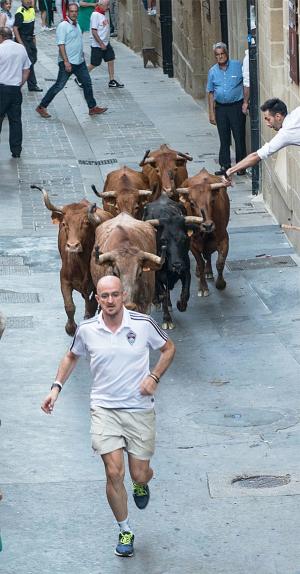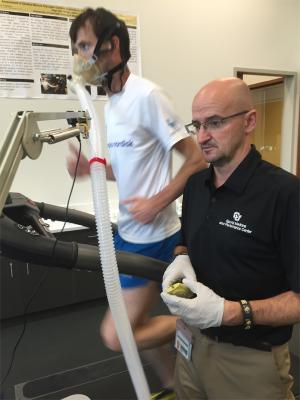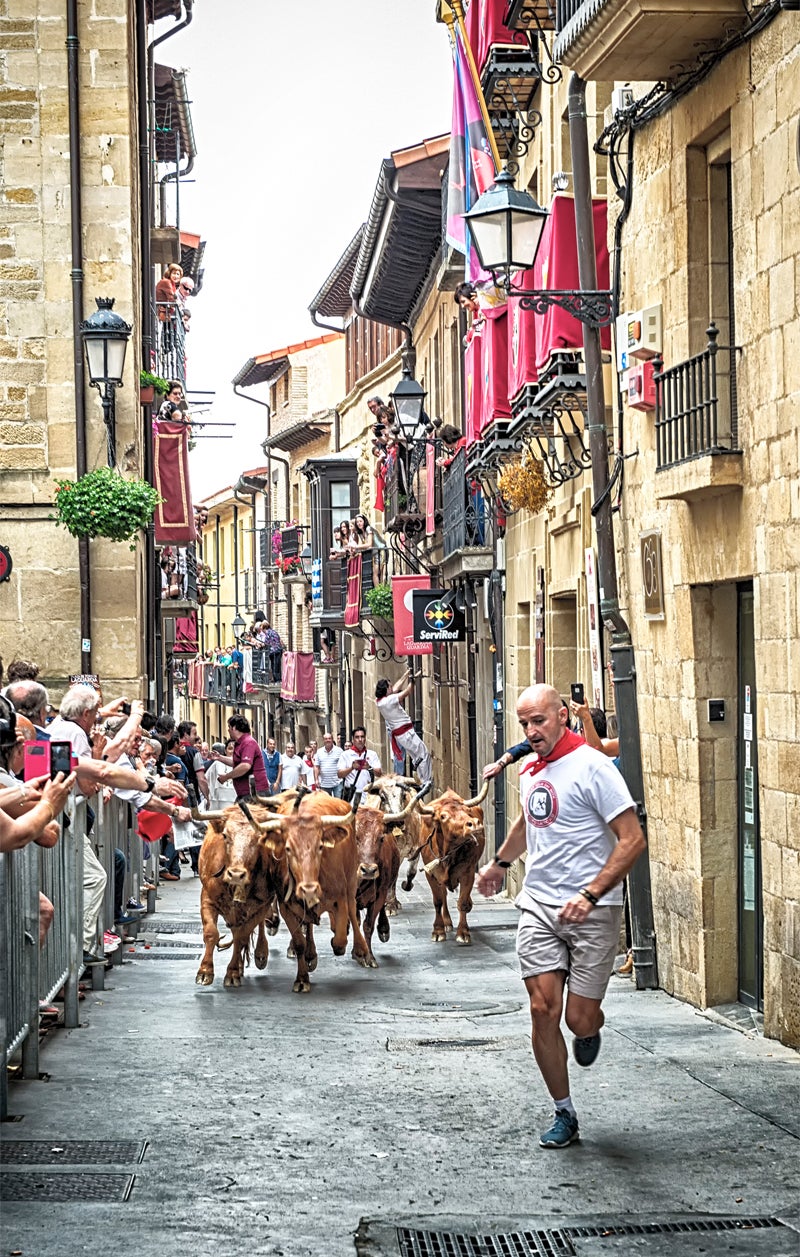Five questions for Iñigo San Millán
Iñigo San Millán knows how athletes think and what they feel because he has been there, first as a soccer player with Real Madrid and then as a professional cyclist. So his transition to sports medicine and research on making the human body perform at its best was a good fit.

“My passion when I was an athlete was to understand how the human body works. To train better, increase performance, make my engine better. All of that led me to this career,” San Millán said. “I said the day I retire (from cycling) I want to continue working with athletes. Being a former athlete, I speak the language, I have every single feeling that athletes go through from joy to tears to pain.”
After working for 20 years as an exercise physiologist and sports medicine adviser for professional teams and elite athletes, he came to the University of Colorado, where he is director of the Sports Performance Department and Physiology lab at the new CU Sports Medicine and Performance Center at CU Boulder, as well as an assistant professor in the Department of Physical Medicine and Rehabilitation at the CU School of Medicine at the Anschutz Medical Campus. He still works with elite and recreational athletes, but also uses his knowledge of the human body to promote health and wellness.
The folks at his Sports Performance program and Physiology Lab worked with several Olympians before they departed for Rio de Janeiro for competition, including CU alumni and track stars Jenny Simpson and Emma Coburn; 100-meter world champion swimmer and Olympic silver medalist James Magnussen; and Lea Davison, who is representing the United States in mountain biking after placing second in the world championships. (Read more about CU at the 2016 Summer Games.)

San Millán, along with his colleague John Hill from the School of Medicine, also developed a methodology to measure glycogen and is working with USA cyclists using this technology. Glycogen, a form of energy storage, previously was measured with a muscle biopsy.
“Now we can scan your muscle with high-frequency ultrasound and within 10 to 15 seconds, we can give you your measurement, sort of like a gas indicator in your car,” he said. He also took his methodology to the hospital’s ICU and is trying to use it to help critically ill patients, which he has shown to have little or no energy to continue fighting for survival. “We think this can have tremendous applications with critically ill patients and emergency medicine.”
San Millán still bikes several times a week and plays soccer with a coed team.
“I always find time to exercise,” he said. Every summer, he returns to his native Spain for the running of the bulls, a feat he has enjoyed since his teens. He doesn’t run in Pamplona, where he said the danger comes from tripping over other people, but in different areas of the country, where “you can control when you get out of there.”
1. At the Human Performance Laboratory, you use high-tech tests to help elite and recreational athletes and overweight people find the right exercise “fit” for them to improve performance, get healthy or lose weight. Explain your methodology and how science helps all of these people.
We work in four areas. First, we work with elite and professional athletes, including Olympic athletes. They come here with their coaches and we work with them to individualize and recommend specific training programs. We monitor them for training and fatigue, and we try to improve their overall performance. The second field we work in is for your recreational athlete. Especially in states like Colorado, there are thousands of people who are entering a triathlon or half-marathon or a century ride every week. This is your typical 30- to 60-year-old who has a goal of becoming competitive. Before, they were jogging around the block for fitness purposes, and now they really want to quality for an event or be the fastest in their group category or improve their personal best. The majority don’t know how to train or what to eat; we give them guidance and programs to follow.
The third area concerns health and wellness, specifically exercise as medicine. This is a new area that we’re very excited about because we have the first program on campus for exercise as medicine. About eight years ago, the American Medical Association and the American College of Sports Medicine got together to launch a new program called exercise as medicine. The idea was that we have to do something different, think out of the box, and not just give people pills and more pills. We know that exercise helps prevent a majority of diseases that are chronic and non-communicable. The idea is to prescribe exercise instead of pills. Now we are applying that philosophy with individualized and personalized exercise programs for people with Type 2 diabetes or pre-Type 2 diabetes or for obese or overweight individuals that need to lose weight but for whom nutrition alone won’t do it.
We know that mitochondrial dysfunction is behind the pathogenesis of many metabolic diseases like Type 2 diabetes and obesity, and also behind the pathogenesis of cardiovascular and even Alzheimer’s disease. Now it is called cardio-metabolic disease because about 80 percent of patients share the diseases. We also know that mitochondrial function, which produces the energy currency of a cell and regulates cellular metabolism, is the best mechanism for performance in elite athletes. We also know that elite endurance athletes – 100 percent of them – are the only population that doesn’t exhibit acquired forms of cardio-metabolic disease, yet there are no other humans on the planet that eat as much sugar or carbs.
I’ve been working with this population for 20 years and I know what mechanisms protect them from disease, and we are using that knowledge to help us to understand why those mechanisms are faulty in people with Type 2 diabetes, for example. In other words, I believe that we can never get to understand imperfection if we don’t understand what perfection is in the first place, and elite endurance athletes represent the perfect physiology and metabolism.
One of the things I have developed is a methodology to measure mitochondrial function and metabolic flexibility, a new term. I presented my work in Germany in Berlin at a mitochondria conference and it was well-received – they didn’t throw tomatoes at me. We are applying that methodology here in the lab, and we are very excited because we are pioneers in the area. In essence, we measure metabolic flexibility and mitochondrial function to see how well it is working. We know that the only method to improve mitochondrial function is exercise, so if the function isn’t working well, we adjust the exercise dose accordingly. That is the whole concept of exercise as medicine: individualizing and personalizing exercise intensity and duration because there is no one-size-fits-all when it comes to training and improving mitochondrial function. We know that so many people lose weight, for instance, but then gain it all back. It doesn’t work because the program they were following wasn’t sustainable.
Our program is always a two-year process, especially for people who haven’t exercised in recent memory or 10 or 12 years. We hold their hands for one year, closely monitoring what they are doing. I always say that you have to imagine that you have a potato field and you want to plant a vineyard there and produce great wine. First, you have to get rid of the potato field. Then you have to plant and water and aerate for a whole year. You won’t have a harvest that year, but toward the end of the year, you’ll see flowers and young vines. The first year of our program is about changing things little by little. The second year, you reach stability. We hear about extreme diets and extreme exercise and we know that none of those work because they don’t create sustainability. You ask people if they can do these things for the rest of their lives and the answer is, “Hell no,” so there you go. We cater to each individual and monitor them so the program is sustainable and enjoyable.
The final area we are working in is research and development. We’ve been contacted by companies to help with innovative products. There’s a revolution in the fitness and health world thanks to wearables and biosensors. Most wearables measure metabolism and we are experts in that area. We also have access to those populations – from world-class athletes to people with disease. We’re entering contract negotiations now to perform R and D with some of the big players and start-ups in the market.
2. You’ve trained world-class athletes in numerous sports. During each Olympics, we watch amazing feats of performance. How does 31-year-old Michael Phelps continue to win races against younger athletes? Does it all come down to proper training or does something else play a role?
As a whole, there is a shift happening across all sports. We’re seeing people who are peaking or getting their best results in their mid- or late 30s. There are two reasons for this. First, there used to be this mentality that says when you hit 30, you are old. Some of these athletes had been swimming since they were 6 years old, but once you finished your college years, there really wasn’t a way to continue as a professional. People wouldn’t give you a contract and at some point, you had to make a living. The whole dogma was that at age 25, you couldn’t perform as well and had to quit your sport. That’s one area that has been proven wrong, and now, there are more professional opportunities for older athletes.
Additionally, training is better and sports science is better so that athletes can recover better throughout their careers. Training and nutrition is better monitored so careers can be extended. For an athlete that gets injured, and needs surgery or rehab, the techniques are better and guarantee better outcomes. Of course, Michael Phelps is an incredible athlete, too, so he can continue getting great results.
3. What is the toughest sport(s) to excel in? Is there a limit to human performance?
Individual sports across the board are very difficult, both because of the physicality and the mental aspect. Team sports have two advantages: all of the weight of performance is not on you all of the time and practice is usually much shorter. Mentally, if things go well, everybody’s happy; but if things go wrong, it doesn’t all rest with you, its spread over the entire team. With the individual, if things go wrong, everything is on your shoulders, and mentally, it’s hard to come back from that.
As for a limit, I think there has to be a limit to performance, and maybe, in some sports, we are almost there. If you look at the last 20 to 30 years, the improvements in performance have been minimal. Finish times aren’t 10 minutes faster, but maybe 1 minute faster. In the 100-meter swim, for instance, world records aren’t being beaten and improvements are measured in tenths of a second. In team sports, however, we’ve seen huge improvement. Sports like cycling and running are 40 years ahead of many sports, whereas sports like football are still in prehistoric times. Team sports are starting to show improvement and now players are faster, leaner, better athletes.
4. Doping is a hot topic in the Olympics, especially because of charges against Russian athletes. Does the specter of doping mar the reputation of all athletes?
The whole evolution in sports science means athletes train better and recover better and that has really helped athletes. Unfortunately, doping has always been there and I guess it always will be. It is inherent human behavior – whether in sports or politics or other fields of life – that someone wants to cut corners and cheat. But in sports, there are more measurements out there and more sophisticated equipment to detect doping and help guarantee a more level playing field.
5. You’ve worked with so many athletes. Have you received a gift from one of them that has special meaning for you?
I’ve been lucky to work with athletes over the years and so we have multiple jerseys and shirts from them that are signed. But one of my favorite things I have in my office is something my wife gave to me. It’s a picture of Leonardo da Vinci’s inventions. He was an incredible personality, an architect, he studied anatomy and science, and he was a painter and musician. He performed all of these at high levels. How many times have we been told, “You cannot do everything; you have to focus on one thing.” But da Vinci said no to limits and so the picture reminds me that we should not place limits on ourselves.



